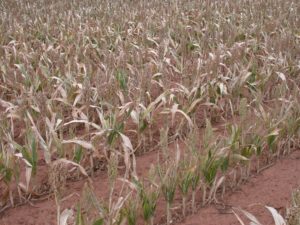Dr. Calvin Trostle, Extension Agronomy, TAMU Dept. of Soil & Crop Sciences, Lubbock, (806) 746-6101, ctrostle@ag.tamu.edu
When our next Row Crops Newsletter is published in early November, a large portion of Texas will have seen heavy frost and a freeze on some sorghums. So, this is good time to update Texas on prussic acid (a plant form of cyanide) and nitrates in sorghums. These include sorghum/sudans (haygrazers), forage sorghums, and also grain sorghum where cattle will graze after harvest or on drought-failed grain sorghum (Fig. 1). Sorghum after grain harvest and failed sorghum may still be green and growing. Thus, prussic acid and nitrate concerns remain valid.
Fig. 1. Droughted grain sorghum with insufficient grain filling for harvest. This field is being grazed. Poor growth suggests that nitrate accumulation is a possible toxic issue. Also, since many of the plants are still alive, an immediate rain could trigger regrowth which may potentially have prussic acid issues.
After 22 years in the Texas High Plains I still learn nuances on this topic. Issues with prussic acid and nitrate have their exceptions, and blanket statements sometimes find exceptions, for better or worse. I note, too, our veterinary medicine community is sometimes unclear about these chemicals in sorghums (and nitrate can be an issue in other forages as well) and their effect on animal safety.
Staff at Texas A&M’s Texas Veterinary Medical Diagnostic Lab regularly deal with prussic and nitrate issues in livestock. They note it is difficult to test for prussic acid in an animal (for example, sample the rumen) after mortality and measure prussic acid. A quick autopsy after death can much more readily identify symptoms of nitrate poisoning.
Generally, concerns about prussic acid arise at the first moderate frost to light freeze in any sorghum family crop being grazed. It is best to remove the cattle for at least a week. If a sorghum is cut for forage, the time it takes the forage to dry for baling is sufficient for prussic acid to dissipate from leaves and stalk. Dissipation from a large stalk is slower, but then that stalk takes longer to dry out.
Nitrate is perhaps less considered as a potential health issue for livestock. Potential nitrate issues are not related to a frost or freeze. In my region of Texas nitrates are rarely an issue in a forage crop that is irrigated. The problem often is more pronounced when plants are stressed and not growing well. But they are still accumulating nitrate, primarily in the base of the stalk. Nitrates do not dissipate in a forage at the end of the season as a crop matures and dries down. They do not dissipate in a forage cut for hay.
Texas A&M AgriLife information on the topic continues online at “Nitrates and Prussic Acids in Forages,” http://soiltesting.tamu.edu/publications/E-543.pdf
The above document notes that nitrate poisoning can occur in several different species of forage crops as well as numerous weeds. The weed most likely to accumulate nitrate is pigweed (Palmer ameranth, carelessweed). We have plenty pigweed in much of Texas, perhaps even more so now since most pigweed is now resistant to glyphosate (Roundup). Animals in my region have died when feeding on excessive pigweed in baled sorghum/sudan.
Additional recommended information that further explains these topics was recently updated by Dr. Brent Bean, national sorghum agronomist, United Sorghum Checkoff Program, https://www.sorghumcheckoff.com/news-and-media/newsroom/2020/08/12/avoiding-prussic-acid-and-nitrate-poisoning/ This document is a good read. One item of note on nitrate is some labs report as NO3– (the nitrate anion) but most report as “nitrate-nitrogen” or NO3–N.
A Key Difference
As noted, prussic acid dissipates in properly cured hay whereas nitrate remains fixed. Both are a danger to grazing cattle. I commonly see problems in the understanding of prussic acid (which is mostly in the leaves, the first portion of standing forage cattle would consume), how to test it, and what test results mean.
Recommended Testing Labs & Proper Sampling/Shipping for Prussic Acid
There are many labs across Texas that can test for prussic acid and nitrate. You may prefer to use a lab that you can take the samples to directly, particularly for prussic acid. Prussic acid sample collection can be tricky. How the samples are handled can skew the results. Good results—and the best interpretation of what these results mean—I believe is found by using the services of Texas A&M’s Texas Veterinary Medical Diagnostic Lab (http://tvmdl.tamu.edu/). Their full-service labs are in College Station and Amarillo. Laboratory staff are keen on proper sample collection. They welcome your phone call to ensure you do this properly. Regardless of what lab you may decide to use, I recommend you call in advance for their instructions on how to handle the sample.
You can read TVDML’s tip sheet for further advice about proper collection and shipping samples (even if not shipping to TVDML) especially for prussic acid testing at https://tvmdl.tamu.edu/shipping/
